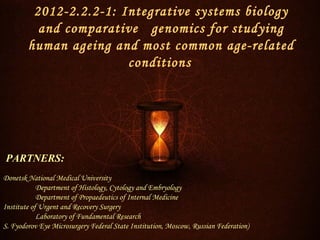
Ageing
- 1. 2012-2.2.2-1: Integrative systems biology and comparative genomics for studying human ageing and most common age-related conditions PARTNERS: Donetsk National Medical University Department of Histology, Cytology and Embryology Department of Propaedeutics of Internal Medicine Institute of Urgent and Recovery Surgery Laboratory of Fundamental Research S. Fyodorov Eye Microsurgery Federal State Institution, Moscow, Russian Federation)
- 2. Drugs, nutrients, lifestyle Aging is programmed or simply determined by interactions between environmental and genetic factors
- 3. Cellular determinants of ageing •Insulin/insulin-like growth factor-1 (IGF-1) • Reactive oxygen •Fox-head transcription factors (FOXOs) • Mitochondria dysfunction •Klotho gene • DNA damage •HSP • Telomere attrition •Antioxidants • Lysosomal dysfunction •Sirtuins • Sress-ER •Sestrins • Proteosome dysfunction
- 4. Tissue and organ determinants of ageing Key mechanisms of development: Key features: • Changes of Autonomic innervation: • blood pressure increase desympathization, increase sensitivity of target cells to epinephrine, changes in vessels tone • atherosclerosis regulation; • may contribute to myocardial infarction • Endothelial dysfunction - deficient of NO, and stroke decrease of cytoprotection, loss of • limiting adult stem cell life span antiaggregation and barrier function, changes in • wound/ ulcers healing problems angiogenesis; • renal / cardiac sclerosis • Dysfunction of specialized cells • Immunological ageing • Altered epithelio-mesenchymal interactions (reduced IGF1 and Wnt2; increased TGFβ, ECM hyperproduction) • Cytokine network disturbance (dendritic cells dysfunction)
- 5. P R E L I Vascular Specialized cells Connective tissue M Endothelium cells (pigment epithelium) I N PG I2 NО PEDF A PG E2 NО EGF ILGF R Y Endothelin-1 ACE bFGF VEGF AngII Extracellular matrix TGFβ TGFβ hyperproduction S Pigment T Endothelial epithelium U dysfunction dysfunction D Published: “Pathology of eye at pseudoexfolliation syndrome” – M., 2010. – 156 p. Y Method of early diagnostics of glaucoma at pseudoexfoliation syndrome (patent of Russia №2010116856) The pathogenesis of open-angle glaucoma with pseudoexfoliationsyndrome // Ophthalmology. – 2010. – Vol. 3. – p. 106.
- 6. Integrative model for early diagnostics and prognosis Approach for analysis Morphology Inhibitor analysis Immunocytochemistry (blood cells as model) Clinical Verification Integrative analysis of Genes symptoms Individual reactivity polymorphism •Disease stage/degree •Kinetics of cells •Receptors sensitivity Functional •Cellular types and activities microRNA •Intracellular signaling loading tests •Chemical composition of matrix (Phospholipases, Ca2+, eNOS, Adenilyl Cyclese, Phosphodiesterases, •Functional reserve Protein Kinases A, C, G) CELLULAR AND MOLECULAR TARGETS
- 7. Preliminary results: diabetes mellitus. Complications Prognosis of diabetic wound healing Monocytes Platelets CD 68 + Arginase iNOS Aggregation 300 240 Violation of microcirculation, platelets release of 5-HN, TXA2 etc 180 120 Cytokines NO 60 Induce CD 31 + adhesion Arachidonic acid metabolites 0 К 1 day 3 days 10 days 20 days Endothelial dysfunction NADPН-oxidase р38-МАРК AGEs -Adreno- and adenosine receptors sensitivity ROS iNOS Са2+ AT1 receptors (X1) -Protein kinase C hyperstimulation α -SMA cAMP - PkА PkА ↑↑↑ПкС ↑↑↑ПкС CGMP - PkG - ↓ eNOS / PDE5 (X2) Y= -0,032 × X 1 -0,0029 × X 2 + Y= -0,03 × Х1-0,082 × Х2-1,652 1,630 Ycrit=0,515 Published in : Clinical surgeryсrit =0,281 Physiological Journal, 2011. Y . - 2009, 2010.
- 8. Thank you for attention
